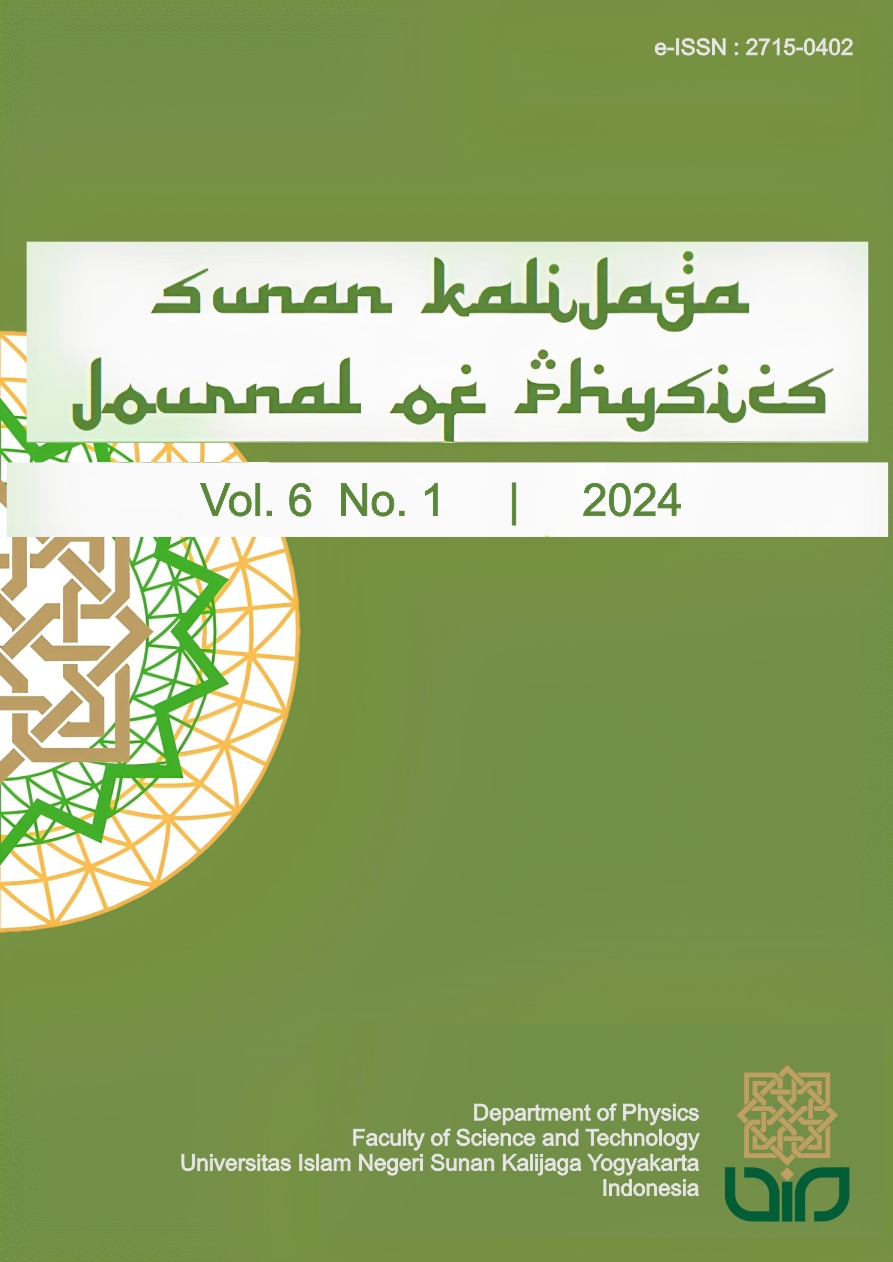Earthquake Hazard Analysis in Probolinggo Region as a Mitigation Effort Using Probabilistic Seismic Hazard Analysis Method
Analisis Bahaya Gempa Bumi Di Wilayah Probolinggo Sebagai Upaya Mitigasi Menggunakan Metode Probabilistic Seismic Hazard Analysis
DOI:
https://doi.org/10.14421/physics.v6i1.5153Keywords:
Earthquake hazard, PSHA, PGA, Vs30, ProbolinggoAbstract
Probolinggo is one of the areas traversed by an active fault, namely the Probolinggo Fault. As an area that is prone to earthquake disasters, Probolinggo needs to have an earthquake hazard modeling as a mitigation effort to minimize the impact of an earthquake that occurs in the future. Earthquake hazard modeling is a multidisciplinary science that aims to predict earthquakes, and the ground shaking they produce. One method that can be used is Probabilistic Seismic Hazard Analysis (PSHA). This study aims to analyze the earthquake hazard in Probolinggo area using the PSHA method as an effort to mitigate earthquake prone areas. The data used is historical earthquake data from the Agency for Meteorology, Climatology, and Geophysics (BMKG) for the 1973-2020 period with a magnitude of Mw ≥ 5, a depth of 0-300 km, and a radius of 300 km from the study area. The earthquake source model used includes megathrust, faults, and background earthquake sources. Three sets of Ground Motion Prediction Equation (GMPE) were used for each earthquake source. PSHA was performed for the condition of a 2% probability of being exceeded in 50 years. The average shear wave velocity to a depth of 30 m (Vs30) from the United States Geological Survey (USGS) were used to model the peak ground acceleration on the surface. The results showed that the peak ground acceleration (PGA) at bedrock ranged from 0.27 to 0.71 g. PGA at the surface (PGAM) ranges from 0.27 to 0.83 g. The distribution of the amplification value in Probolinggo area is 1.02 to 1.12. The earthquake hazard analysis obtained shows that the northern part of the Probolinggo area has a higher earthquake hazard than the southern part. The results of the study can be used as consideration in regional development based on earthquake risk reduction.
References
Pusgen, Peta Sumber dan Bahaya Gempa Indonesia Tahun 2017, Bandung, Indonesia: Pusgen, 2017.
H. T. Verstappen, Indonesian Landforms and Plate Tectonics, 2010.
Pemerintah Kabupaten Probolinggo, "Kondisi Geografis," [Online]. Available: https://probolinggokab.go.id/kondisi-%20geografis/. [Accessed: Apr. 24, 2024].
Badan Meteorologi Klimatologi dan Geofisika (BMKG), "Katalog Gempabumi Signifikan dan Merusak 1821-2023," [Online]. Available: https://yogyakarta.bmkg.go.id/buletin-mkg/katalog-gempa-bumi-signifikan-merusak-tahun-1821-2023/. [Accessed: Apr. 24, 2025].
S. A. Kumala and Wahyudi, "Analisis Nilai PGA (Peak Ground Acceleration) untuk Seluruh Wilayah Kabupaten dan Kota di Jawa Timur," INERSIA, vol. 12, no. 1, pp. 34–37, 2016, doi: 10.21831/inersia.v12i1.10348.
J. Sulastri and B. Sunardi, "Pendekatan Probabilistik untuk Penilaian Bahaya Gempabumi Kawasan," in Seminar Nasional Geofisika 2016, Semarang, Nov. 2016, pp. 85–92.
A. R. Salsabil, A. Hilyah, M. S. Purwanto, and M. H. M. Fajar, "Zonasi Bahaya Kegempaan Akibat Patahan Aktif di Wilayah Jawa Timur dengan Pendekatan Deterministik Menggunakan Perhitungan Atenuasi Chiou-Youngs 2014 NGA," Jurnal Geosaintek, vol. 4, no. 3, p. 103, 2018, doi: 10.12962/j25023659.v4i3.4508.
J. Nugraha, G. Pasau, B. Sunardi, and S. Widiyantoro, "Analisis Hazard Gempa dan Isoseismal untuk Wilayah Jawa-Bali-NTB," Jurnal Meteorologi dan Geofisika, vol. 15, no. 1, Apr. 2014, doi: 10.31172/jmg.v15i1.168.
A. Susilo and Z. Adnan, "Probabilistic Seismic Hazard Analysis of East Java Region, Indonesia," Int. J. Comput. Electr. Eng., pp. 341–344, 2013, doi: 10.7763/ijcee.2013.v5.728.
Rumahpengetahuan.web.id, "Kota-Kota Besar Dilintasi Sesar," [Online]. Available: https://rumahpengetahuan.web.id/kota-kota-besar-dilintasi-sesar/. [Accessed: Apr. 20, 2024].
USGS, "Vs30 Map Viewer," [Online]. Available: https://usgs.maps.arcgis.com/apps/webappviewer/index.html?id=8ac19bc334f747e486550f32837578e1. [Accessed: May 24, 2024].
Badan Informasi Geospasial (BIG), "Indonesia Geospatial Portal," [Online]. Available: https://tanahair.indonesia.go.id/portal-web/login. [Accessed: May 22, 2024].
C. Reyes and S. Wiemer, "ZMAP7, A Refreshed Software Package to Analyze Seismicity," 2019. [Online]. Available: http://www.seismo.ethz.ch/en/research-. [Accessed: Apr. 2024].
J. K. Gardner and L. Knopoff, "Is the Sequence of Earthquakes in Southern California, With Aftershocks Removed, Poissonian?," Bull. Seismol. Soc. Am., vol. 64, no. 5, 1974.
M. Irsyam et al., "Ringkasan Hasil Studi Tim Revisi Peta Gempa Indonesia 2010."
P. Purbandini, B. J. Santosa, and B. Sunardi, "Analisis Bahaya Kegempaan di Wilayah Malang Menggunakan Pendekatan Probabilistik," Jurnal Sains dan Seni ITS, vol. 6, no. 2, Sep. 2017, doi: 10.12962/j23373520.v6i2.25221.
B. M. Hutapea, "Analisis Hazard Gempa dan Usulan Ground Motion pada Batuan Dasar untuk Kota Jakarta," Jurnal Teoritis dan Terapan Bidang Rekayasa Sipil, vol. 16, no. 3, 2009.
M. Ordaz, F. Martinelli, J. Arboleda, C. Meletti, and V. D’Amico, "R-CRISIS: Program and Platform for Computing Seismic Hazard," 2017.
Badan Standardisasi Nasional (BSN), SNI 1726:2019: Tata Cara Perencanaan Ketahanan Gempa untuk Struktur Bangunan Gedung dan Non Gedung, [Online]. Available: https://rekayasastruktur.com/sni-1726-2019/. [Accessed: Feb. 19, 2024].
A. B. Simanjuntak, G. Yuliyanto, and D. U. Harmoko, "Analisis Resiko Kebencanaan Gempa Bumi Data Mikrotremor di Desa Fulolo Kecamatan Alasa Kabupaten Nias Utara," 2017.
Downloads
Published
How to Cite
Issue
Section
License
Copyright (c) 2025 Muhammad Taufiq Akbar Al Ghifari

This work is licensed under a Creative Commons Attribution-ShareAlike 4.0 International License.




